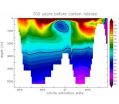INFORMATION:
Delta Cephei's hidden companion
2015-05-12
(Press-News.org) To measure distances in the Universe, astronomers use Cepheids, a family of variable stars whose luminosity varies with time. Their role as distance calibrators has brought them attention from researchers for more than a century. While it was thought that nearly everything was known about the prototype of Cepheids, named Delta Cephei, a team of researchers at the University of Geneva (UNIGE), the Johns Hopkins University, and the European Space Agency (ESA), have now discovered that this star is not alone, but that it has a hidden companion. A revelation published in The Astrophysical Journal.
Delta Cephei, prototype of Cepheids, which has given its name to all similar variable stars, was discovered 230 years ago by the English astronomer, John Goodricke. Since the early 20th century, scientists have been interested in measuring cosmic distances using a relationship between these stars' periods of pulsation and their luminosities (intrinsic brightness), discovered by the American Henrietta Leavitt. Today, researchers from the Astronomical Observatory of UNIGE, the Johns Hopkins University, and the ESA show that Delta Cephei is, in fact, a double star, made up of a Cepheid-type variable star and a companion, which had thus far escaped detection, probably because of its low luminosity. Yet, pairs of stars, referred to as binaries, complicate the calibration of the period-luminosity relationship, and can bias the measurement of distances. This is a surprising discovery, since Delta Cephei is one of the most studied stars, of which we thought we knew almost everything.
A secret companion
As the scientists from Geneva and Baltimore measured Delta Cephei's pulsations with the Hermes spectrograph, installed at the Mercator telescope based on La Palma, one of the Canary Islands, an unexpected signal was detected. Using high-precision Doppler spectroscopy (developed and used for researching exoplanets), the researchers discovered that the speed with which Delta Cephei approaches the Sun is not constant, but changes with time in a characteristic fashion. This change of speed can only be explained by the presence of another star, which orbits around Delta Cephei. In other words, there is a secret companion, whose existence we did not suspect. By combining their own observations with data from the scientific literature, the researchers determined the orbit of the two stars and observed that the mass of the companion is low (around 10 times lower than the mass of Delta Cephei).
«We were shocked: despite all the attention Delta Cephei was given over the years, we were lacking an essential piece of information», states Richard Anderson, researcher at UNIGE at the time of the discovery, first author of the article and now researcher at Johns Hopkins University, in the United States.
According to the scientists, the data collected in the framework of ESA's Gaia space mission will enable Delta Cephei's orbit to be precisely measured. The presence of the companion must consequently be taken into account when the Gaia team determines the Delta Cephei's distance.
«Although our study does not challenge the cosmic distance ladder as a whole, improving the precision of every one of its rungs will eventually benefit cosmology», explains Richard Anderson. "This discovery reminds us that something is always to be learned. If even one of the closest Cepheids is keeping such secrets , who knows what we will discover about the ones furthest from us!»
A turbulent past?
Due to its excentric orbit, Delta Cephei is sometimes further and sometimes closer to its companion. This suggests a very dynamic evolution, since the two stars are approaching each other to within twice the Earth-Sun distance (astronomical unit) every 6 years, which is a small distance for a Supergiant star such as Delta Cephei whose radius is 43 times larger than that of the Sun. Delta Cephei's excentric orbit thus points to interactions between the two stars due to tidal forces that occur when they are close to each other. This could help the interpretation of other astronomers' work in the past, who have observed a strange circumstellar environment, for which no definitive explanation has been found yet.
This study is likely to inspire further research aiming to better understand the evolution of Delta Cephei, since binarity is an essential property to consider for interpreting the evolution of a star. Studying the evolution of Cepheids is particularly interesting, since it helps to improve the understanding of the structure and evolution of stars in general. «We are waiting for the results from new measurements taken with the Hermes spectrograph and the observations from Gaia. These will allow us to precisely trace the possibly turbulent past of Delta Cephei", the astronomers anticipate. "It is a fascinating adventure!»
ELSE PRESS RELEASES FROM THIS DATE:
Brazilian beef industry moves to reduce its destruction of rain forests
2015-05-12
MADISON, Wis. -- Expansion of cattle pastures has led to the destruction of huge swaths of rain forest in Brazil, home to the world's largest herd of commercial beef cattle. But a new study led by the University of Wisconsin-Madison's Holly Gibbs shows that market-driven "zero deforestation agreements" have dramatically influenced the behavior of ranchers and the slaughterhouses to which they sell.
Publishing today [May 12, 2015] in the journal Conservation Letters, the research team - including other UW-Madison scientists, the National Wildlife Federation, and IMAZON ...
Nothing fishy about new way to produce sunscreen pill and lotion
2015-05-12
Scientists from Oregon State University have discovered that fish can produce their own sunscreen. They have copied the method used by fish for potential use in humans.
In the study published in the journal eLife, scientists found that zebrafish are able to produce a chemical called gadusol that protects against UV radiation. They successfully reproduced the method that zebrafish use by expressing the relevant genes in yeast. The findings open the door to large-scale production of gadusol for sunscreen and as an antioxidant in pharmaceuticals.
"The fact that the compound ...
Cardiovascular risk factors extremely high in people with psychosis
2015-05-12
Extremely high levels of cardiovascular risk factors have been found in people with established psychosis, with central obesity evident in over 80 per cent of participants, in a study by researchers from the NIHR Biomedical Research Centre at the South London and Maudsley NHS Foundation Trust (SLaM) and King's College London.
In the largest study of its kind in the UK, drawing on a sample of more than 400 outpatients with psychosis, it was discovered that nearly half of the sample were obese (48 per cent), with a body mass index (BMI) of 30 or more. Additionally, nearly ...
Solution to corrosive ocean mystery reveals future climate
2015-05-12
Around 55 million years ago, an abrupt global warming event triggered a highly corrosive deep-water current to flow through the North Atlantic Ocean. The origin of this corrosive water has puzzled scientists for a decade.
Now, researchers have discovered this current and how it formed. The findings, published today in Nature Geoscience, also have profound implications for the sensitivity of our current climate to carbon dioxide emissions.
The researchers explored the acidification of the ocean that occurred during a period known as the Paleocene Eocene Thermal Maximum ...
A fine-tuned approach improves platelet generation from stem cells
2015-05-11
A low platelet count can occur as the result of a variety of medical conditions and as a medication side effect. Platelet transfusion is often required for individuals with a critically low platelet level. Currently, the primary source of platelets is volunteer donors. Unfortunately, donated platelets have an extremely short shelf life and can be in limited supply. A new study in the Journal of Clinical Investigation reports on a method to generate progenitor cells from murine embryonic stems that are able to produce a large number of functional platelets. Mitchell Weiss ...
Group B Streptococcus breaches the blood-brain-barrier
2015-05-11
Bacterial meningitis is a life-threating infection of the central nervous system. Group B Streptococcus (GBS) is the leading cause of meningitis in newborn babies and can cause severe complications in those that survive the infection. GBS must cross the blood-brain-barrier (BBB) to cause disease but it is not clear how these organisms breach this barrier. A new study in the Journal of Clinical Investigation identifies a pathway that is induced by GBS and disrupts junctions between cells. Kelly Doran and colleagues at San Diego State University determined that GBS induces ...
Vineyard habitats help butterflies return
2015-05-11
PROSSER, Wash. - Washington wine grape vineyards experimenting with sustainable pest management systems are seeing an unexpected benefit: an increase in butterflies.
Over the years, loss in natural habitat has seen the decline in numbers of around 50 species of butterflies in eastern Washington. But in a recent Washington State University study published in the June issue of the Journal of Insect Conservation, researchers found that vineyards that create nearby natural habitats have three times the number of butterfly species and four times more butterflies than conventional ...
An important step in artificial intelligence
2015-05-11
In what marks a significant step forward for artificial intelligence, researchers at UC Santa Barbara have demonstrated the functionality of a simple artificial neural circuit. For the first time, a circuit of about 100 artificial synapses was proved to perform a simple version of a typical human task: image classification.
"It's a small, but important step," said Dmitri Strukov, a professor of electrical and computer engineering. With time and further progress, the circuitry may eventually be expanded and scaled to approach something like the human brain's, which has ...
Certain immigrants, refugees at higher risk of psychotic disorders
2015-05-11
TORONTO (May 11, 2015) -- Immigrants from the Caribbean and Bermuda, as well as refugees from East Africa and South Asia, have a 1.5 to 2 times higher risk of psychotic disorders compared to the general population of Ontario, Canada, according to a new study by researchers at the Institute for Clinical Evaluative Sciences (ICES) and the Centre for Addiction and Mental Health (CAMH). The study also found that immigrants from Northern Europe, Southern Europe and East Asia had about half the risk of psychotic disorders compared to the general population.
The study published ...
High-performance 3-D microbattery suitable for large-scale on-chip integration
2015-05-11
By combining 3D holographic lithography and 2D photolithography, researchers from the University of Illinois at Urbana-Champaign have demonstrated a high-performance 3D microbattery suitable for large-scale on-chip integration with microelectronic devices.
"This 3D microbattery has exceptional performance and scalability, and we think it will be of importance for many applications," explained Paul Braun, a professor of materials science and engineering at Illinois. "Micro-scale devices typically utilize power supplied off-chip because of difficulties in miniaturizing ...




